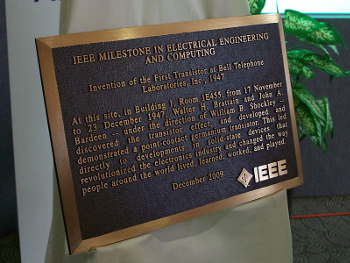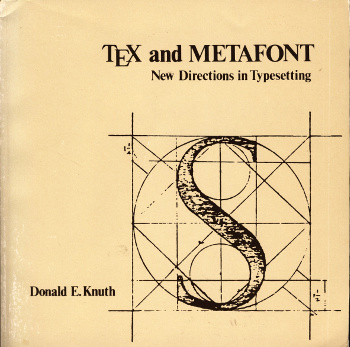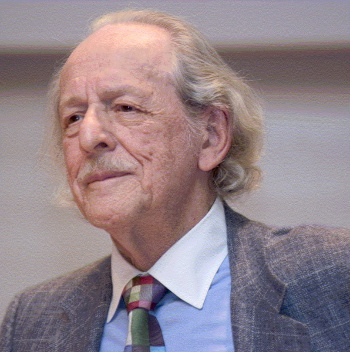Eugene Garfield (1925-2017)
April 3, 2017
While many
theoreticians might object to the statement, progress in
science comes principally as a result of advances in
instrumentation. Examples of this abound in the
history of science.
Galileo's telescope caused a
revolution in
astronomy. The development of the
vacuum tube enabled a
plethora of
electronic measurement equipment subsequently improved by the
invention of the
transistor. For current examples, we have the $10 billion
Large Hadron Collider, and the
Laser Interferometer Gravitational-Wave Observatory that gives us great science for less than a $billion.

Commemorative plaque marking the demonstration of the transistor, dedicated at Bell Labs on December 8, 2009.
(Photo by the author, via Wikimedia Commons. Click for larger image.)
The
computer is one
scientific tool that's greatly enhanced the practice of all scientific
disciplines. Aside from the incorporation of computers into instrumentation for
automated analysis and
data acquisition, computers make
publication of
scientific papers much easier.
My generation was the last
generation to do
least-squares curve fitting of our
data by hand.
Publication before computers was a chore, with
manuscripts created on a
typewriter, the
graphs hand drawn using
India ink, and the
photographs produced in a
darkroom using a primitive
chemical imaging method involving
colloidal silver halide. After
peer review, manuscripts were revised, retyped, and accepted by the publisher, who then undertook the tedious process of rendering the text and graphics for
mechanical printing. Since errors were always expected in this tedious process, especially in the proper rendering of
mathematical equations, the publisher would send
page proofs for correction.
Today,
document preparation programs, such as the
LaTeX distribution of
Don Knuth's TeX, allow an
author to
eliminate the middle man, so to speak, to give him full control of his paper. Not only that, but the
Internet has allowed a more rapid distribution of scientific papers, and
open access options allow any interested reader to read these papers at no charge.

Cover of Don Knuth's 1979 book, "TeX and METAFONT: New Directions in Typesetting."[1]
Metafont is a vector font description language.
(Scan of my copy.)
Before the Internet, the only way to read scientific papers was the get a
journal subscription, typically through membership in a
scientific society, find them at a
university library with enough funding to pay for an expensive institutional subscription, or get a
reprint from one of the authors. While the later option generally got you a copy at just the cost of a
postcard's postage, you still needed to identify the papers that captured your interest.
Eugene Garfield, who died on February 26, 2017, at age 91, simplified this process for many
scientists by creating
Current Contents.[2-3]
Current Contents, of which I was an avid weekly reader, was first published in 1977. Its simple concept, direct images of the recent
tables of contents of the most important scientific journals, along with the addresses of paper authors, allowed an easy means of securing reprints of papers. Current Contents included a weekly one-page summary of a so-called Citation Classic, one of the most cited papers in the scientific literature.[4]
Current Contents followed by more than a
decade another of Garfield's publications, the 1964
Science Citation Index, a directory of how frequently articles in the scientific literature had been
cited. This, of course, is a measure of the importance of the work, and such a ranking was often used by universities in their academic promotions, such as
tenure. One interesting aspect of this is that papers describing
analytical techniques have many citations, although they would be classified as "
normal science."[5]
The paper with the most citations (more than 300,000) is a paper by
biochemist,
Oliver Lowry (1910-1996), on an
assay for the amount of protein in solution.[6] Lowry was encouraged to publish the assay by his
colleague and eventual
Nobel laureate,
Earl Sutherland (1915-1974), who complained about always referring to "an unpublished method of Lowry."[7]
Eugene Garfield was born on September 16, 1925, in
New York City. First a
chemist, having obtained a
BS degree in
chemistry from
Columbia University in 1949, he obtained a 1954
master's degree, also from Columbia University, in
library science.[2] He continued for a
Ph.D. in
structural linguistics at the
University of Pennsylvania in 1961,[3] albeit on a chemical topic, an
algorithm for
translating chemical nomenclature into
chemical formulas.[8]

Eugene Garfield (1925-2017).
This photo was taken on May 9, 2007, when Garfield received the 2007 Richard J. Bolte Sr. Award from the Chemical Heritage Foundation.
(A Chemical Heritage Foundation photograph, via Wikimedia Commons.)
Garfield, who preferred to be known as an
information engineer or
information scientist, rather than a
librarian, was assuredly an
entrepreneur.[2] He founded the
Institute for Scientific Information (ISI) in
Philadelphia, Pennsylvania, in 1955.[2] Long before ubiquitous computing made
databases common, he assembled scientific information into a readily accessible form that aided study and diminished duplicate research.[2] His
journal impact factor was both important, and problematic. It was used at ISI to determine which journals should be indexed, but it became a metric for academic ranking, a practice that Garfield disliked.[3]
Garfield founded
The Scientist in 1986, a publication he considered a "
trade magazine" for working scientists.[2-3] The Scientist published science news, and also articles on
policy and
ethics that are not found in scientific journals.[3] This magazine continues today, thirty years after its founding.[3] ISI was sold in 1988 for $24 million, and it was sold, six years later, to the
Thomson Corporation for $210 million.[3] It is now owned by
Clarivate Analytics.[2]
At his death, Meher Garfield, Garfield's
wife, said that he was mindful of his humble beginnings, he never became arrogant in his success, and he thought of his
employees as his
extended family.[3] He was a supporter of the Philadelphia
poverty and
homelessness advocacy group,
Project HOME.[2] In his spare time, he enjoyed reading and
windsurfing.[2]
Vitek Tracz, a former co-owner of The Scientist, is quoted on The Scientist web site as saying,
"Everything he did, he was ahead of everybody in so many ways...He was a genius of a very special type. Not only because he had this incredible imagination and brain, but he had incredible tenacity and courage."[3]
References:
- Donald E. Knuth, "TeX and METAFONT: New Directions in Typesetting," The American Mathematical Society and Digital Press, 1979, 105 pp., ISBN: 0-932376-02-9.
- Bonnie L. Cook, "Eugene Garfield, 91, created an indexing system for scientific knowledge," philly.com, March 13, 2017.
- Scientometrics Pioneer Eugene Garfield Dies, The Scientist, February 27, 2017.
- Eugene Garfield, "Short History of Citation Classics Commentaries," Garfield Library, University of Pennsylvania.
- Richard Van Noorden, Brendan Maher, and Regina Nuzzo, "The top 100 papers," Nature, October 29, 2014.
- O. H. Lowry, N. J. Rosebrough, A. L. Farr, and R. J. Randall, "Protein measurement with the folin phenol reagent," J. Biol. Chem., vol. 193 (November 1, 1951), pp. 265-275.
- Nicole Kresge, Robert D. Simoni and Robert L. Hill, "The Most Highly Cited Paper in Publishing History: Protein Determination by Oliver H. Lowry," The Journal of Biological Chemistry, vol. 208, no. 28 (July 15, 2005), p. e25.
- Eugene Garfield, "An Algorithm for Translating Chemical Names to Molecular Formulas," Journal of Chemical Documentation, vol. 2, no. 3 (July 1962), pp. 177-179, DOI: 10.1021/c160006a021
Permanent Link to this article
Linked Keywords: Theory; theoretician; science; scientific instrument; instrumentation; history of science; Galileo Galilei; telescope; scientific revolution; astronomy; vacuum tube; plethora; electronic; measuring instrument; measurement equipment; invention; transistor; Large Hadron Collider; LIGO; Laser Interferometer Gravitational-Wave Observatory; commemorative plaque; Bell Labs; Wikimedia Commons; computer; scientific; discipline; automation; automate; analytical chemistry; analysis; data acquisition; publication; scientific literature; scientific paper; baby boomer; generation; least-squares; curve fitting; data; pencil; manuscript; typewriter; Cartesian coordinate system; graph; India ink; photograph; darkroom; photographic film; chemical imaging; colloid; silver halide; peer review; printing press; mechanical printing; mathematical equation; page proof; word processor; document preparation program; LaTeX; Donald Knuth; TeX; author; middle man; Internet; open access journal; Metafont; vector font; scientific journal; subscription business model; scientific society; university; library; reprint; postcard; postage; Eugene Garfield; scientist; Current Contents; tables of contents; decade; Science Citation Index; citation; cite; tenure; normal science; biochemist; Oliver Lowry (1910-1996); Lowry protein assay; assay for the amount of protein in solution; colleague; Nobel laureate; Earl Sutherland (1915-1974); New York City; chemist; Bachelor of Science; BS degree; chemistry; Columbia University; master's degree; library science; Doctor of Philosophy; Ph.D.; structural linguistics; University of Pennsylvania; algorithm; translation; chemical nomenclature; chemical formula; Richard J. Bolte Sr. Award; Chemical Heritage Foundation; information engineer; information scientist; librarian; entrepreneur; Institute for Scientific Information (ISI); Philadelphia, Pennsylvania; database; journal impact factor; The Scientist; trade magazine; policy; ethics; Thomson Corporation; Thomson Reuters-Clarivate Analytics; wife; employee; extended family; poverty; homelessness; advocacy group; Project HOME; windsurfing; Vitek Tracz; genius; imagination; intellect; brain; tenacity; courage; Donald E. Knuth, "TeX and METAFONT: New Directions in Typesetting," The American Mathematical Society and Digital Press, 1979, 105 pp., ISBN: 0-932376-02-9.